The result? I do not like the very dry and spongy texture that results from this method. The texture is different from more authentic freeze dried tofu called "shimidoufu" 凍み豆腐 or "kouyadoufu" 高野豆腐. My wife liked this version more than I did. Certainly I do not think this is worth the effort.
Saturday, November 5, 2011
Baked marinated tofu redux ピリ辛豆腐のオーブン焼き 第2弾
When I posted baked marinated tofu, I promised I would try it with frozen and thawed tofu. Here is the dish.

Tofu: I used firm tofu and froze it 24 hours in a freezer without taking it out of the package. The next day, I moved the frozen tofu to the refrigerator. It took two days to completely thaw. After that, I drained any excess moisture as I did with a regular tofu.
Thursday, November 3, 2011
Japanese Insalata Caprese 日本風カプレーゼサラダ
The title is a bit of stretch. This is a combination of miso marinated fresh mozzarella cheese, thin slices of tomato, perilla leaves and grilled miso.

The mozzarella cheese was marinated for a week (we just forgot we had this) in the mixture of miso and mirin as described before. I scraped off the miso marinade and sliced it.
We smeared a bit of the grilled miso on the slice of cheese and layered it with a small piece of perilla and a slice of tomato like insalat caprese. We really liked this combination of flavors. My wife really liked the miso and even ate a portion of miso I did not eat. That night, however, she was very very thirsty.
I used a sharp knife to remove the tomato skin (but I could have blanched it first). To make it more attractive, I made it to a "rose". If you are interested in making a tomato rose or flower, here is the instruction with pictures (in Japanese).
Grilled miso: I simply smeared the miso marinade in a thin layer in a porcelain spoon and held it over the gas fire for few minutes until the surface became brown and the miso was fragrant.
We smeared a bit of the grilled miso on the slice of cheese and layered it with a small piece of perilla and a slice of tomato like insalat caprese. We really liked this combination of flavors. My wife really liked the miso and even ate a portion of miso I did not eat. That night, however, she was very very thirsty.
Tuesday, November 1, 2011
Japanese style coleslaw with hot-smoked pork tenderloin 日本風コールスローと豚ヒレ肉の薫製焼き
Since my wife does not particularly like raw shredded cabbage, I usually end up making variations of coleslaw when I'm in the mood to eat some cabbage. I am not sure where I got the idea of adding raisins to coleslaw but I must have eaten coleslaw made that way in Japan. In any case, this is another quick snack made from whatever was available to go with a drink. The previous weekend, we barbecued (hot smoked) pork tenderloin (seasoned with chopped rosemary, black pepper and salt) which I have been using for sandwiches etc. This is the last of this pork. It has a spicy taste from both the smoke and black pepper.

Coleslaw: As a side, I quickly made this Japanese (I am not sure it is a Japanese or whatever) style coleslaw. I julienned cabbage after removing the thick veins. I then salted, mixed, and let it stand for 10 minutes and squeezed out the excess moisture. Meanwhile I plumped some raisins in a mixture of white vermouth and hot water (about a one to one ratio) for 5-10 minutes. I added mayonnaise and Dijon mustard to the cabbage. I tasted and added freshly cracked black pepper but no more salt (it was salty enough). I removed the excess liquid from the raisins and mixed them into the cabbage.
Pork: After I thinly sliced it, I dressed it with semi-thick "tonkatsu" sauce and Japanese hot mustard mixture.
This was followed by marinated tuna "sashimi". Instead of the usual side of daikon garnish, I made an instant "diakon" namasu, dressed in a mixture of mirin and sushi vinegar, and served it with the fine chopped meat of umeboshi or "bainiku" 梅肉 on the top.
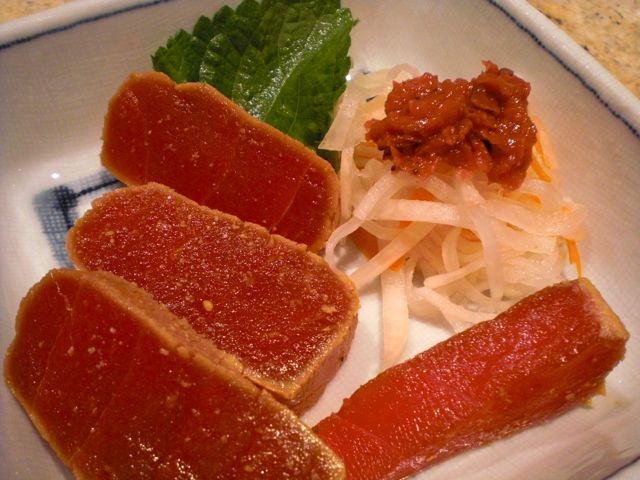
Again, we had cold sake. This time we tasted "junmai" sake from Kyoto, Kizakura 黄桜 Touzai Living Jewel. This is from a large sake brewery but made from Yamada nishiki. It is a light but nicely fruity and rather easy-to-drink sake, perfect for hot summer days, best chilled ice cold.
Pork: After I thinly sliced it, I dressed it with semi-thick "tonkatsu" sauce and Japanese hot mustard mixture.
As usual, I also added a drunken tomato. This is again nothing dish but rather spicy taste of pork went well with this coleslaw. The raisins added a nice sweet taste.
This was followed by marinated tuna "sashimi". Instead of the usual side of daikon garnish, I made an instant "diakon" namasu, dressed in a mixture of mirin and sushi vinegar, and served it with the fine chopped meat of umeboshi or "bainiku" 梅肉 on the top.
Sunday, October 30, 2011
Matsutake "chawanmushi" savory egg custard 松茸の茶碗蒸し
I have posted "chawanmushi" 茶碗蒸し or Japanese savory egg custard before. "Chawan" means "bowl" (more literally "tea bowl" but this word is usually used to just mean a generic bowl) and "mushi" means to steam. Although this is a very popular dish in Japan, only rarely do you see it served in Japanese restaurants in the U.S. Since I got fresh matsutake from Oregon mushroom and I posted most of the ways I can think of to serve matsutake before, I decided to make chawanmush with matsutake.
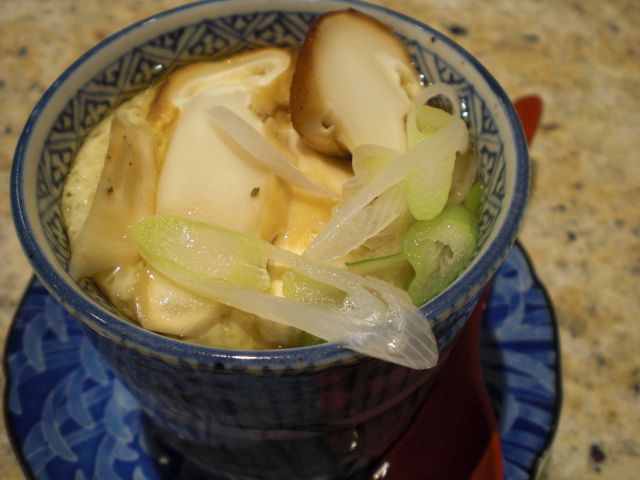
Although I have traditional lidded containers specifically designed for chawanmush, I have been using a set of 6 small bowls for chawanmush for sometime (picture below). I am not sure where I got this one but probably by mail order. This must have been for export, since the traditional Japanese set is either 5 or 10. In any case, three eggs make the perfect amount for these 6 small bowls. The two important tips to make good chawanmushi is the ratio between the eggs and the broth and how to steam it.
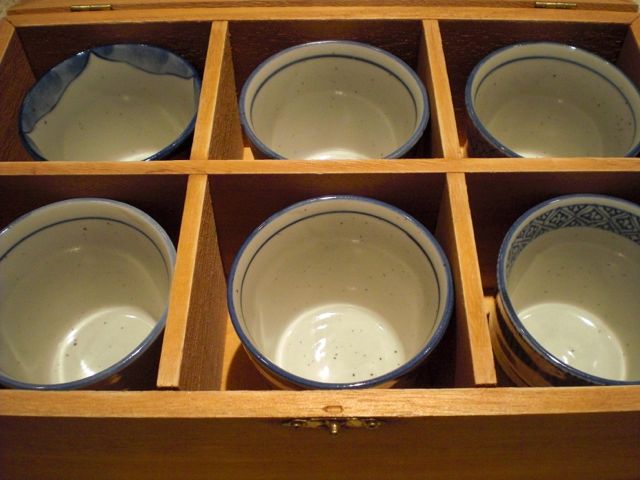
Matsutake: I had two relatively large matsutake left. After I cleaned it, I sliced it.
Eggs: I used 3 large eggs. Since the size of eggs is not uniform, I measured the amount after lightly beating the eggs (this time, it was 150ml).
Broth: I made dashi broth using a dashi pack (kelp and bonito kind). The amount of liquid should be 3 times of the eggs. (In my case, the final broth should be 150ml x 3 =450 ml). I first measured about 400ml of the broth and I added light colored soy sauce or "usukuchi shouuyu" 薄口醤油 (1 tbs) and mirin (1tbs). (Taste and if the saltiness is not enough, add salt instead of soy sauce to prevent further darkening the color of the custard. I did not need it this time). I added more broth to make it exactly 3 times of the eggs (in this case, 450 ml).
Egg mixture: I mixed the broth and the eggs trying not to make too many bubbles on the surface. It is important to strain the egg mixture through a fine sieve. If not strained, Chalaza and other chunks of egg white will congeal in chawanmushi producing a very unpleasant white hard spot.
Other ingredients: Since the main feature of this chawanmushi was matsutake, I only used a few other items in this dish; ginko nuts (prepared, in a can, 5-6 in each bowl) and thinly sliced chicken tenderloin (2). After I placed the ginko nuts and the chicken meat in each bowl, I poured in the strained egg mixture. If I had it, I would have used mitsuba 三つ葉 for granish but instead, I had to settle for thinly sliced (on a slant) scallion.
Steaming: I used an electric wok. I started on medium high heat with continuos steam for 2 minutes or so and turned it down to low intermittent steam. After 5 minutes when the surface became lighter yellow and congealed, I placed sliced matsutake and scallion on the top and continued steaming for another 15-20 minutes until a clear liquid started coming or from the custard.
I have to admit the difference between using fresh shiitake mushroom (my usual) and mastutake is subtle but there is a sublime subtle aroma and flavor of matsutake. This dish is so delicate only cold sake could be our choice of libation. Over the next few days I served the remaining chawanmush cold (I could have made cold broth which can be poured over it but I did not). Even cold, it is very good.
Friday, October 28, 2011
Tuna and Salmon roe 'yamakake" 鮪といくらのやまかけ
This post indicates than it is getting harder and harder for me to come up with new dishes to post. These are some of the dishes I served when we were tasting the new batch of G-sake "joy". The yamakake was the 4th dish after octopus sumiso-ae, braised potatoes and green beans and "ankimo" with orange marmalade soy sauce.
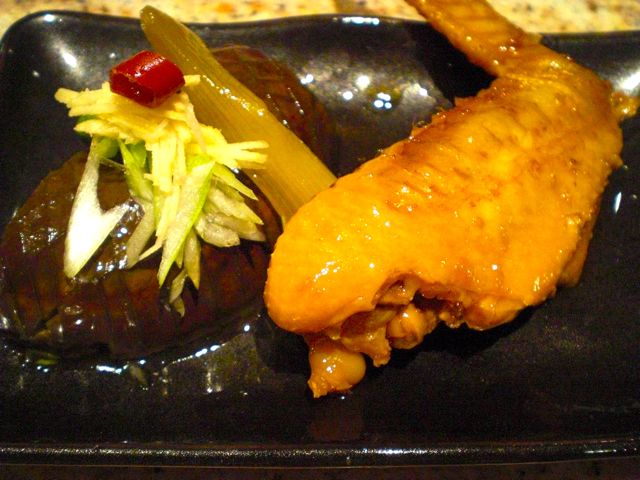
The stewed eggplants are also nice to have since it also tastes better next day or later served cold. For this batch, I used a whole dried red pepper cut up instead of red pepper flakes, which made the dish a bit more spicy than usual.
The only variation of this "yamakake" was to add salmon roe or "ikura" to this dish. Again, the tuna sashimi is from frozen "yellow-fin" tuna block from my freezer which was marinated in sake and soy sauce (1:1) overnight. I used home-grown perilla as the garnish. As usual, I dissolved wasabi in soy sauce and mixed it into the grated nagaimo before serving.
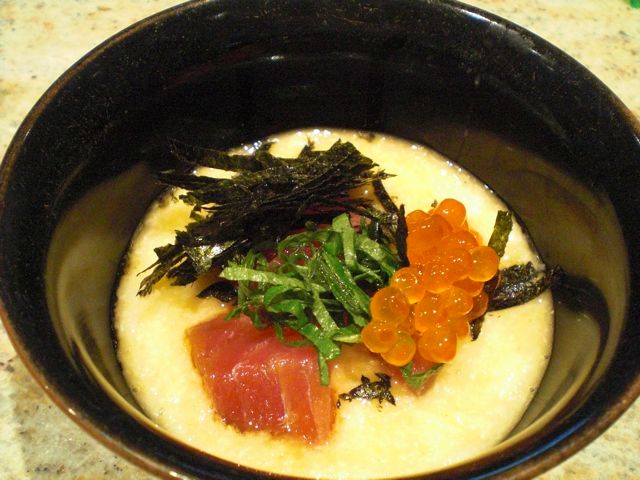
We progressed into simmered eggplant (with Italian eggplant) served cold. We also reheated simmered chicken wings. This chicken wing dish is getting to be our favorite. It is so easy to make and tastes even better after a few days, reheated. At my wife's suggestion, I also cooked bone-in chicken thighs the same way. Instead of nice collagen from the skin and tendons of the wings, the thighs were much meatier and also tasted excellent.
There is nothing really new here but showing our Izakaya dishes in sequence.
Wednesday, October 26, 2011
Pasta with black truffle and cream sauce 黒トリュフとクリームソースパスタ
This is an extravaganza I prepared using the remaining black truffles. If we could not taste or smell black truffles with this pasta dish, we have to give up tasting truffles. I made this as simple as I can make it without garlic and without red pepper flakes; just olive oil, salt, cream, and garnish of chopped chives.
I just cooked the Angel hair pasta according to the instructions on the package. Meanwhile, I sliced off both ends of a black truffle and minced it. In a frying pan, I heated good olive oil and sautéed the pasta and mixed in the minced truffle, seasoned it with salt and cream (3-4 tbs) and reduced it for a few minutes. Off heat, I added thinly sliced truffles as you can see in the picture above. (I used a small sharp utility knife since I did not have a truffle slicer).
I just cooked the Angel hair pasta according to the instructions on the package. Meanwhile, I sliced off both ends of a black truffle and minced it. In a frying pan, I heated good olive oil and sautéed the pasta and mixed in the minced truffle, seasoned it with salt and cream (3-4 tbs) and reduced it for a few minutes. Off heat, I added thinly sliced truffles as you can see in the picture above. (I used a small sharp utility knife since I did not have a truffle slicer).
The taste? Well, this amount of truffles, we should be able to taste them. They definitely had a good earthy aroma wafting from this dish. The taste? I am not sure. It has a interesting texture and more aroma than the taste. Although my wife said it was something familiar, something she has tasted before.
We decided to go with a very inexpensive (but got 90 from Robert Parker) Riondo Prosecco for this dish. This effervescent light wine with floral note was perfect without overwhelming the truffle.
Monday, October 24, 2011
Black truffle with creamy scrambled egg 黒トリュフとクリーミーいり卵
When I ordered fresh matsutake from Oregon mushroom, I also ordered two small black truffles (from France). My wife says that even when the dish is advertised as having truffles she can't taste anything special. When we went to Paris, she ordered a dish that was smothered in tuffles and she said maybe there was something there but she wasn't sure. So, I decided to splurge and got two Burgundy truffles (left in the image below). This way we could experience truffle by itself so we could identify what flavor the truffle had and find out what the hoopla was all about. The first dish I made was designed to highlight the flavor of truffles. These truffles have a nice earthy aroma which became more pronounced when they were sliced (right in the image below).

I decided to make an egg dish with truffles as the first dish since eggs and truffles are known to go together well. Instead of regular scrambled eggs, however, I used bain marie to make some very creamy scrambled eggs.
I first cut off the both ends of the truffle (right in the image above) and minced it into fine cubes. I then added that to two beaten eggs with cream (2 tbs) and a pinch of salt. On bain marie, I scrambled the egg mixture using a silicon spatula until the eggs reached a very creamy texture. I divided the creamy scrambled eggs into two small egg shaped containers, garnished with thin slices of truffle, chopped chives and freshly cracked white pepper (below).
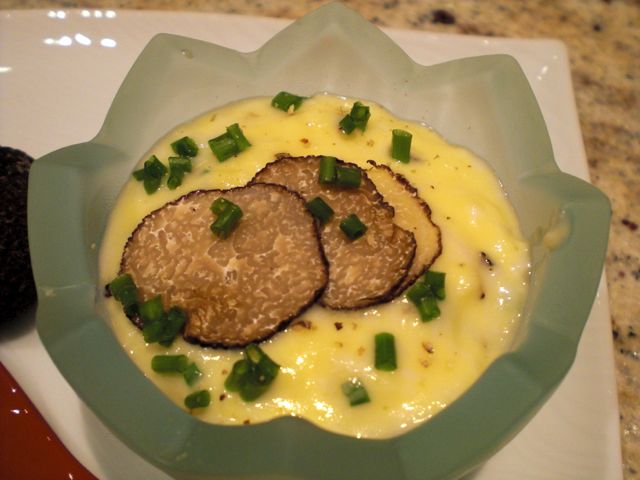
I have to say that the aroma of truffles is very subtle and, by itself, they do not seem to have much taste. The textural contrast between the creamy scrambled eggs and truffle is nice and added a "je ne se qua" to this very nice scrambled egg. The eggs seemed to absorb the flavor and made it seem like the whole dish was truffles. We couldn't help but compare this flavor the the subtlety of Matsutake. Both mushrooms have a very distinctive flavor but truffles are definitely much more subtle. My wife said she found the flavor surprisingly familiar... so THIS is the taste of truffles. Does this mean she actually tasted truffles before and just didn't realize it?
I first cut off the both ends of the truffle (right in the image above) and minced it into fine cubes. I then added that to two beaten eggs with cream (2 tbs) and a pinch of salt. On bain marie, I scrambled the egg mixture using a silicon spatula until the eggs reached a very creamy texture. I divided the creamy scrambled eggs into two small egg shaped containers, garnished with thin slices of truffle, chopped chives and freshly cracked white pepper (below).
Subscribe to:
Posts (Atom)


